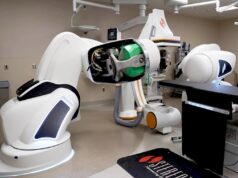
Massachusetts Institute of Technology engineers have created a soft robotics-enabled three-dimensional (3D)-printed anatomical hydrodynamic system that can recreate the hemodynamic system of aortic stenosis (AS) and congenital defects in specific patient cases.
The researchers first took medical images of a patient’s heart, converting these into 3D models which provide the basis for the subsequent polymer print—what is produced is a flexible, hollow replica of the patient’s heart. Mimicking the heart’s pumping action, the researchers also fabricated sleeves which are similar to blood pressure cuffs that wrap around the 3D-printed heart and aorta.
“All hearts are different,” says Luca Rosalia, a graduate student in the MIT-Harvard Program in Health Sciences and Technology. “There are massive variations, especially when patients are sick. The advantage of our system is that we can recreate not just the form of a patient’s heart, but also its function in both physiology and disease.”
In order to test the function of their replica heart, the researchers used medical scans of 15 patients with aortic stenosis, converting each image into a 3D computer model of the left ventricle and aorta, and subsequently using this to print the shell and sleeves, creating an artificial pumping system.
Measuring each patient’s heart-pumping pressures and flows, the study authors outline in Science Robotics, were able to accurately match the heart’s mechanics and physiology to each individual—“that is the part we get excited about”, noted co-author Ellen Roche (Cleveland Clinic, Ohio, USA).
Developing their models even further, the investigators state they were able to replicate the interventions several patients had previously undergone to measure whether the replica heart responded in the same manner. Roche and her colleagues implanted similar valves in the printed aortas modelled after each patient. When they activated the printed heart to pump, they observed that the implanted valve produced similarly improved flows as in actual patients following their surgical implants.
Finally, the team used an actuated printed heart to compare implants of different sizes, to see which would result in the best fit and flow—something they envision clinicians could potentially do for their patients in the future.
“Patients would get their imaging done, which they do anyway, and we would use that to make this system, ideally within the day,” says co-author Christopher Nyugen (Massachusetts General Hospital, Boston, USA). “Once it is up and running, clinicians could test different valve types and sizes and see which works best, then use that to implant.”
Ultimately, Roche says the patient-specific replicas could help develop and identify ideal treatments for individuals with unique and challenging cardiac geometries.
“Designing inclusively for a large range of anatomies, and testing interventions across this range, may increase the addressable target population for minimally invasive procedures,” Roche says.












